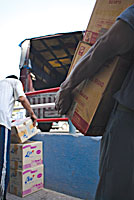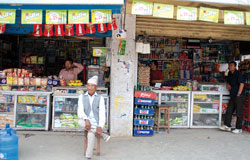|
|
On the 600 metre stretch of road between Pulchok and Jawalakhel there are three big supermarkets. At Kamal Pokhari, the fancy new City Centre Mall is coming up. Just in the past two years, we have seen the opening of the United World Trade Centre and the Kathmandu Mall.
Despite a burgeoning mall culture, Kathmandu's citizens haven't given up on their neighbourhood kirana pasal. In fact, these mom and pop stores are doing quite well despite the competition from the megastores.
Economic liberalisation in the 1990s brought a flux of imported foreign goods, and middle-class incomes rose because of remittances from abroad. The economy went into freefall during the conflict years, and is only now picking up.
|
|
But despite growth since Bluebird became the first supermarket in Kathmandu 22 years ago, there are still only eight supermarkets and malls for the Valley's population of 2 million. So, for most of the population the neighbourhood shop is still where they buy most of their basic needs.
Kathmandu's family grocery shops have been slightly affected by supermarkets, but only if they used to be located near a big mall. "Kirana pasals are still a trusted part of the local community," says business analyst Ashutosh Tiwari, "many allow regulars credit and they serve as social centres for their neighbourhood."
Ram Shrestha in Sanepa has been patronising the same grocer for more than 20 years, eschewing the range of goods available in the supermarket just a stone's throw away. "The owner provides a good service and makes me feel important," he says.
Most Kathmanduites believe kirana pasals are cheaper than supermarkets, although this is not always the case. For instance, Druk canned pineapple slices cost Rs 100 at Bhatbhateni but Rs 106 at a neighbourhood store in Patan; Rara instant noodles cost Rs 10 at Saleways but Rs 11 at a family grocer.
|
|
Some Kathmandu supermarkets wonder if their failure to capture a larger share of the market is because of lack of marketing. But they say instability in the country makes investing in a long-term advertising campaign too risky. Apart from that, Arpana Mohpal, managing director of Trends Advertising and Marketing Consultants, explains: "Brand loyalty is non-existent in Nepal."
At the end of the day Nepal is still a low-income country, with a small middle class and low purchasing power. "Comparing us to America or even India is like comparing an apple to an orange" says Binod Tuladhar, executive director of Bluebird Mall.
Tuladhar says big retail business is constricted by employment laws and powerful unions, and complains that he loses a lot of money from inefficiency among staff. The overheads for small shops are much less and in many cases staff are unpaid family members who help out when they are free.
| ||||||||||||
Kirana pasals are now getting in on the act with imported foodstuffs. Uttam provision shop at Pulchok, for example, has brought in fancy foreign imports to meet the demand of expats staying in the area.
Entertainment may be the way for big players to expand their market. In July a new mall, City Centre, will open at Kamal Pokhari. It will stand five storeys high, will be fully air-conditioned, and will have a multiplex cinema, supermarket and a wide range of international brands.
This may be the first of many. In 10 or 15 years' time, the retail landscape of Kathmandu may be very different. But malls will have a long hard battle to capture the hearts and minds of Kathmanduites.





